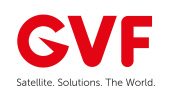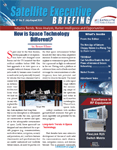Thought Leadership in 5G Satellite Integration
by Martin Jarrold
 London, UK, June 2, 2019--Following-on from the Aberdeen, Scotland, Oilfield Connectivity 2019 event back in May, the GVF-EMP Partnership will be presenting its next event – Cellular Backhaul 2019: Satellite and the 5G Journey (www.uk-emp.co.uk/current-events-zone/cellular-backhaul-2019/) – as an embedded feature of the biggest 5G-dedicated event in the world, taking place on 13 June at London’s Docklands ExCeL Center.
London, UK, June 2, 2019--Following-on from the Aberdeen, Scotland, Oilfield Connectivity 2019 event back in May, the GVF-EMP Partnership will be presenting its next event – Cellular Backhaul 2019: Satellite and the 5G Journey (www.uk-emp.co.uk/current-events-zone/cellular-backhaul-2019/) – as an embedded feature of the biggest 5G-dedicated event in the world, taking place on 13 June at London’s Docklands ExCeL Center.
Attendees at Cellular Backhaul 2019 will be able to leverage a just recently established and innovative post-event facility on the new GVF website at www.gvf.org, a facility which was introduced immediately following the Aberdeen program and which complements the Partnership’s long-standing practice of making available PDF versions of panelists introductory remarks-supporting slide decks. This slide deck availability – after the event with public domain and free-of-charge access for all interested parties, not just attendees – continues on the EMP website, but now, in addition, GVF’s newly branded and designed website (which was launched during SATELLITE 2019 in Washington DC) provides a Post-Event Summary page where event delegates – and those not able to attend in person – can read an encapsulation of event proceedings, outcomes, and conclusions. The Aberdeen Summary can be viewed here https://gvf.org/news/category/post-event-summary/. Additionally, GVF members can sign-in to the website and use this functionality as a platform to ask questions, engage with event attendees and continue the dialog, post-event.
The Cellular Backhaul 2019 program in London – the second to be embedded within the KNect365 ‘5G World’ and ‘IoT World Europe’ events, part of ‘Tech XLR8’, and in association with ‘Smart Transportation & Mobility’ – will be dedicated to exploring the current interaction between the satellite and wireless industries, the current and future growth of data traffic from mobile devices and how that will impact both cellular and satellite networks as they increasingly converge and integrate.
At no earlier point in the genesis of mobile communications is the success of the next generation of networking technologies so dependent upon the take-up of network services by industry vertical markets. This is clearly reflected in the qualitative nature of 5G, a quantum leap beyond the person-to-person communications focus of earlier generations of mobile and towards a device-to-device ecosphere of the Internet of Things, or as it is often characterized, the “Internet of Everything Everywhere”.
With a series of roundtable-style formats across four themed panel-based sessions, Cellular Backhaul 2019 – which is supported by principal sponsor XipLink and by Comtech EF Data, Hughes, Newtec, iDirect, SES Networks and Gilat Satellite Networks – offers ‘5G World’ attendees a series of thought-leadership explorations of the problems, risks and opportunities that exponential data traffic growth offers to both satellite and wireless industries and to the businesses that will rely on future integrated communications networks.
A very full program will feature panelists from ALCAN Systems; Astranis Space Technologies; CGI; Comtech EF Data; Eutelsat; Gilat Satellite Networks; Hughes; Inster; Integrasys; Intelsat; Isotropic Systems; Kratos; Newtec; SES; SES Networks; Spacebridge; TeleSat; VT iDirect; and, XipLink.
Panel #1, Unlocking Opportunities via Satellite… Beyond the Backhaul Opportunity & Paradigm Shifting Integration with “the Network”, will feature a dialog between Michael DiPaolo, Vice President Cellular Backhaul Business Development, Comtech EF Data; Marco Mirante, Regional Sales Director, Hughes; Semir Hassanaly, Market Director Mobile Backhaul & Trunking, Newtec; John Finney, Founder & CEO, Isotropic Systems; and, Philippe Llau, Head of Data Business Unit MENA & APAC, Eutelsat.
The Mobile Ecosystem… Satellite Use Cases in 5G Deployed Infrastructures, the theme of Panel #2, will be explored by Tim Peyla, Senior Director Business Development, XipLink; Simon Gatty Saunt, Vice President Sales EMEA Fixed-Data, SES Networks; Savyon Wasser, Director Vertical Market Solutions, VT iDirect; Moti Goldshtein, Head of Products, Gilat Satellite Networks; and, Ali Younis, Head of Business Development & Product Marketing, Astranis Space Technologies.
Evolution of Ground Equipment… Infrastructure & Device-to-Device Systems comprises the theme for the next panel, #3, which will be analyzed by Vivek Jhamb, Senior Advisor, TeleSat; Assaf Cohen, General Manager-Global Vice President Sales & Marketing, Spacebridge; Deepukrishnan Pillai, Senior Analyst-Strategy & Market Intelligence, SES; Sebastien Couvet, EMEA Sales Manager, Integrasys; and, Mark Lambert, Vice President Business Development, Kratos.
The final panel of the day, #4, will feature Esat Sibay, Co-Founder & CFO, ALCAN Systems; Jaime Reed, Director Consulting Services, CGI; Javier Santos, Business Development Engineer, Inster; and, Gerry Collins, Director Product Management, Intelsat discussing Architectures and Technologies… Meshing Mobile Wireless & Broadband Satellite.
Facilitating and managing the four panels will be a moderating team with Anver Anderson, Managing Director, Anver Limited; Betty Bonnardel, CEO, AB5 Consulting; Lluc Palerm-Serra, Senior Analyst, NSR; and, me.
With the first 60 Space X StarLink mega-constellation satellites having been launched a matter of days before these words are being written, we are now witnessing the tangible emergence of the satellite industry’s next stage of evolutionary development. The birth of the various “mega-LEOs” – due to be launched over the next few years – will see the orbiting of more data coverage capability than on all the satellite communication payloads ever launched to GEO combined. This LEO evolution significantly adds to satellite’s pre-existing pedigree of close synergy with mobile wireless, a pedigree as old as some of the earliest 2G network backhaul solution deployments across, for example, Africa.
Now, the most significant challenge in the mobile services market is achieving scalable and flexible backhaul – backhaul which is critical to ensure speed and capacity as it relates to the transport of data (and, of course, voice) from distributed network sites to the network core – particularly as markets move to 4G/LTE networks which are forecast to need to support 1,000 times more data traffic by 2020. Terrestrial backhaul optimization technologies cannot solve all challenges, and as a result there is a need for cost-effective mobile backhaul over satellite to relieve congestion.
At this point it is worth noting that whilst the future development of the global digital economy is indeed underpinned by the success of 5G deployment, some analyses of the roll-out of future cellular networks have it that 5G networks will NOT be the norm for some time and that 4G and LTE will continue along a gradual evolutionary path towards 5G. By 2025, the majority of the world’s networks will have only just got to functioning LTE level but will still not yet be 5G.
One consideration for the satellite industry during the period of the 4G/LTE evolutionary journey is to understand how it can beneficially leverage the opportunities inherent in the transitionary period of continued expansion of such networks, before 5G actually “arrives”. Along this evolutionary path satellite will evolve from an “interfacing” technology and service, with a secondary role in the “network”, to an “integrated” technology and service, fully part of an evolving and complex “network of networks”.
For further information and details regarding registration for these conferences, please visit https://gvf.org/event/cellular-backhaul-2019/ and follow the links. Alternatively, please contact Paul Stahl at EMP (Century 21 Communications) – paul.stahl@uk-emp.co.uk – or Martin Jarrold at GVF – martin.jarrold@gvf.org.
-------------------------
 Martin Jarrold is Vice-President of International Program Development of GVF. He can be reached at: martin.jarrold@gvf.org
Martin Jarrold is Vice-President of International Program Development of GVF. He can be reached at: martin.jarrold@gvf.org






